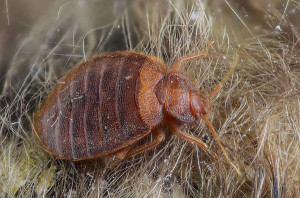Bats Have Bed Bugs. Should You Worry?
By Chris Williams on February 24, 2015.
I just heard on the news that bats have bed bugs, too. Now I’m worried because we have had bats in our attic before. Could their bed bugs get down into the house to bite us? A. D., Medway, MA
It is true that bats have their own bed bugs, Cimex adjunctus and Cimex pilosellus, two species that are closely related to the human bed bug, Cimex lectularius. In fact, some new research has shown that our human bed bug evolved from the bat bed bug. It all started hundreds of thousands of years ago when we lived in caves, along with bats and their parasitic bugs. No doubt those bat bugs fed on the humans in the cave on occasion, over time resulting in a separate species of bugs that preferred to feed on humans because they then didn’t have to compete with the bat bugs for a meal. More blood to go around if you diversify.
But another study of bats in European homes and their parasites surprisingly found that the bugs feeding on the bats were human bed bugs, not bat bed bugs. Yet these bugs did not attempt to feed on the human inhabitants in the homes. They were only interested in the bats’ blood. Researchers think that our human bed bug species may be evolving to split again into two new species with even more specific habits.
Bat bugs and human bed bugs look the same to the naked eye. A professional exterminator or a microscope would reveal that bat bugs have longer hairs on their head and thorax.
Bat Bugs Don’t Really Want to Feed on People
Generally, parasitic insects and mites have their own preferred host animals, but if those animals are no longer available, the blood feeders can be pressured to feed on other substitute animals. Fleas are a good example. Fleas prefer to feed on our dogs and cats and stay with those animals. But, if their host animal dies or moves away, or the flea population is too large, hungry fleas will look to feed on the nearest warm-blooded creature, which may be a human.
It’s the same deal with bat bugs. As long as there are bats to feed on, they will not bother people under normal circumstances. But if the bats are removed, or die, or migrate to another location, bat bugs left behind could search for and feed (somewhat unenthusiastically) on people or pets.
Take Steps to Remove Bats From Your Attic
Blood-sucking bat bugs are only one reason why you don’t want to share your home with bats. The risk of diseases such as rabies and histoplasmosis from bat droppings (guano) are two more reasons.
At Colonial Pest, we have eight certified wildlife specialists who have been doing bat removal for 20 years. Have them check out your attic. If bats are present, spring is the time to remove them, before young are born (see Bat Removal Has a Narrow Window…Don’t Delay!). In Massachusetts, bat exclusion is allowed only in early spring or from August 1 to October 15. We also have a team that specializes in bat exclusion or sealing of openings around your home that allow bats to enter (see Now is the Time to Block Bats From Your Home). We offer a 7-year warranty on our bat removal and bat exclusion services.
Depending on what our specialists find in your bat roost, you may need to have your attic treated once the bats are gone to kill any bat bugs or other parasites that may move down into your home.
By Gilles San Martin from Namur, Belgium [CC BY-SA 2.0], via Wikimedia Commons
Stay up-to-date with Colonial Pest’s email newsletter!
